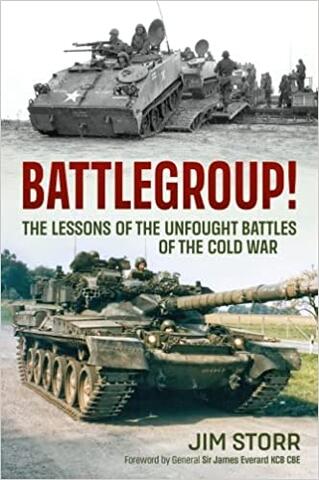Battlegroup!

I enjoyed this book, and if you have any interest in modern mechanized warfare you will too. In Battlegroup professor and former British Infantry Officer Jim Storr takes his considerable, training, knowledge, and experience and condenses it down toward assessing the comparative strengths and weaknesses of the NATO and Warsaw Pact armies that faced off across the East/West German border during the latter part of the Cold War.
If that were all Storr did then this book would still be supremely interesting, especially for anyone who has maybe read fictional accounts of what such combat might look like. Nevertheless, the author takes this book so much further than that. Battlegroup provides an incredibly concise but information packed look at the organization, tactics, training, and equipment of the respective armies amassed in Central Europe during the 1980's.
The focus here is really on the lower tactical levels: from company to brigade, or perhaps division. I especially enjoyed the chapters focusing on defensive and offensive tactics of land warfare such as how to set-up a defensive front, screen, delay, and withdraw as well as on the attacking side how to prepare, assess, attack, and break-through an enemy defensive system all while fighting off counterattacks and doing so in various operating environments including the woods, built up areas and at night. Logistics, close-air-support, and tactical anti-aircraft and anti-tank tactics are also discussed.
As part of this conversation the author is not afraid to pull any punches, particularly in regards to his opinion on the general mis-use of Infantry Fighting Vehicles by NATO armies as well as the almost inexplicable failure of most NATO armies (minus the Germans) to practice effective reconnaissance. For that matter, the book lays into the U.S. and British armies in particular for forgetting the lessons of the Second World War in terms of their doctrinal approach to high-intensity conventional warfare.
Battlegroup is broken down into several sections with the first laying out the strategic and operational setting circa the mid-1980s and the primary armies deployed along the German border. The second section delves into how these armies were organized and analyzes how they would most likely fight. Battlegroup actually begins with a prospective scenario used to illustrate many of its points but closes with nearly a half dozen detailed scenarios illustrating how the Red Army likely would have attacked and the response it might have received from NATO forces.
Though Battlegroup examines how the Soviet and key NATO armies would have fought in several possible scenarios that is really done to highlight the discussion of tactics, training, organization, doctrine, and equipment. This book would make a wonderful present for the amateur enthusiast, professional historian, soldier, or war gamer in your life (if that's you then pick up a copy - you won't regret it).



Post new comment